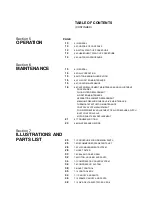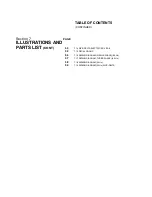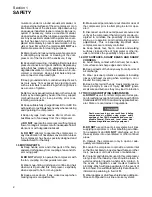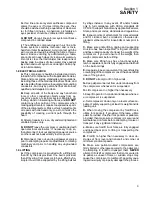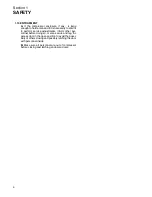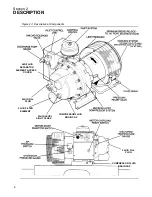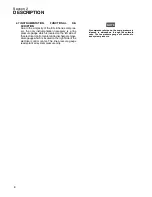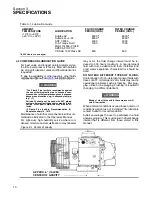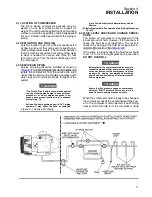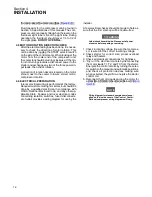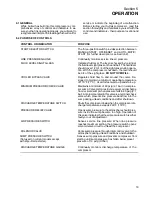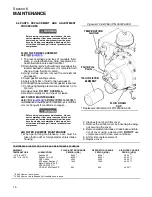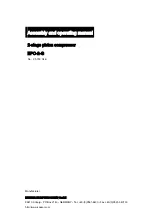
Section 2
DESCRIPTION
5
2.1 INTRODUCTION
Your new Sullair flood--lubricated rotary screw air
compressor will provide you with improved reliability
and greatly reduced maintenance.
Compared to other types of compressors, the Sull-
air rotary screw is unique in mechanical reliability,
with “no wear” and “no inspection” required of the
working parts within the compressor unit.
Read Section 6 (Maintenance) to keep your com-
pressor in top operating condition. Should any ques-
tions arise which cannot be answered in the follow-
ing text, call your nearest Sullair office or the Sullair
Corporation Service Department.
2.2 DESCRIPTION OF COMPONENTS
. T he c om ponent s and as s em -
blies of the ES--6 Series air compressor are clearly
shown. The complete compressor consists of an
encapsulated compressor system, inlet sys-
tem, cooling system
and
control system.
The compact design of the ES--6 Series air com-
pressor provides easy access to all serviceable
components.
2.3 ENCAPSULATED
COMPRESSOR
SYSTEM,
FUNCTIONAL DESCRIPTION
. T he enc aps ulat ed c om pr es s or
includes compressor unit, fluid management sys-
tem, and motor section. The Sullair compressor unit
is a single--stage positive displacement lubricated
type compressor. This unit is equipped with tapered
roller bearings on the discharge, and cylindrical roll-
er bearings on the inlet end for high load carrying ca-
pacity. This unit provides continuous pulse--free air
compression to meet your needs. With a Sullair
compressor there will be no maintenance or internal
inspection of the compressor.
WARNING
!
DO NOT remove caps, plugs and/or other compo-
nents when compressor is running or pressur-
ized.
Stop compressor and relieve all internal pressure
before doing so.
Fluid is injected into the compressor unit in large
quantities and mixes directly with the air as the ro-
tors turn, compressing the air. The fluid flow has
three main functions:
1. As coolant, it controls the rise of air temperature
normally associated with the heat of compres-
sion.
2. It seals the leakage paths between the rotors and
the stator and also between the rotors them-
selves.
3. It acts as a lubricating film between the rotors al-
lowing one rotor to directly drive the other, which
is an idler.
The air/fluid mixture discharges directly into the fluid
management system.
The fluid cooler bypass valve helps assure proper
cooling by directing the fluid to the fluid cooler when
discharge temperature reaches the thermostat tem-
perature setting.
During start--up in cool ambient conditions, the cool-
er pressure drop will cause the filter bypass valve to
open up, assuring adequate fluid supply to the com-
pressor.
All fluid entering the compressor unit passes
through the replaceable fluid filter element. This re-
placeable filter element contains a built--in bypass
valve. Under conditions of restricted flow through
the element, the bypass valve helps ensure ade-
quate compressor fluid flow, as well as helps pre-
vent element failure.
FLUID MANAGEMENT SYSTEM
The fluid management system consists of a multi--
chambered
primary/secondary separator, the fi-
nal air/fluid separator element, cooler bypass
group
and
fluid filter
.
As compressed air/fluid enters the sump, the first
fluid separation takes place due to a reduction of
flow speed coupled with a change of direction of the
flow within the sump housing. Then the compressed
air reaches the separator, where the finest fluid
drops and mist are separated.
MOTOR/DRIVE SECTION
The motor/drive section consists of a squirrel cage
induction motor and integrated drive gearing which
is separated from the motor by a replaceable shaft
seal.
The minimum pressure/discharge check valve is
mounted on the compressor drive housing. Its func-
tions are as follows:
1. Maintain a minimum sump pressure of 60 psig
(4.1 bar) under full load operation to help assure
adequate fluid pressure.
2. Act as a check valve to isolate the compressor
from the system at shutdown or unload.
2.4 COMPRESSOR COOLING SYSTEM, FUNC-
TIONAL DESCRIPTION
The compressor cooling system consists of a
fluid
cooler, fan
and
cooler shroud
.
The fan is mounted on the motor’s shaft end oppo-
site the compressor. Air is drawn over the motor as
well as through the cooler. The air provides motor
cooling and removes compression heat from the
fluid.
2.5 AIR
INLET
SYSTEM,
FUNCTIONAL
DE-
SCRIPTION
The compressor inlet system consists of a
dry--type
air filter
and an
air control valve
. Reacting on a
pressure signal, the valve closes the intake for un-
loaded operation. The valve also acts as a check
valve upon shutdown.
Summary of Contents for ES-6 series
Page 6: ...NOTES...
Page 30: ...Section 7 ILLUSTRATIONS AND PARTS LIST 24 ES 6 COMPRESSOR ASSEMBLY EXPLODED VIEW 5 5 AND 7 5KW...
Page 32: ...Section 7 ILLUSTRATIONS AND PARTS LIST 26 7 3 FLUID MANAGEMENT SYSTEM...
Page 34: ...Section 7 ILLUSTRATIONS AND PARTS LIST 28 7 4 INLET FILTER...
Page 36: ...Section 7 ILLUSTRATIONS AND PARTS LIST 30 7 5 SEAL AND DRIVE GEAR...
Page 38: ...Section 7 ILLUSTRATIONS AND PARTS LIST 32 7 6 MOTOR HOUSING AND PARTS 7 5 10HP 5 5 7 5KW ONLY...
Page 42: ...Section 7 ILLUSTRATIONS AND PARTS LIST 36 7 8 COMPRESSOR SYSTEM...
Page 44: ...Section 7 ILLUSTRATIONS AND PARTS LIST 38 7 9 INLET CONTROL...
Page 46: ...Section 7 ILLUSTRATIONS AND PARTS LIST 40 7 10 CONTROL BOX...
Page 48: ...Section 7 ILLUSTRATIONS AND PARTS LIST 42 7 10 CONTROL BOX...
Page 52: ...Section 7 ILLUSTRATIONS AND PARTS LIST 46 7 12 FRAME CANOPY AND PARTS...
Page 56: ...Section 7 ILLUSTRATIONS AND PARTS LIST 50 7 14 WYE DELTA ELECTRIC BOX ES 6...
Page 58: ...Section 7 ILLUSTRATIONS AND PARTS LIST 52 7 15 DECAL GROUP 7 8 9 11 12...
Page 60: ...Section 7 ILLUSTRATIONS AND PARTS LIST 54 7 15 DECAL GROUP 13...
Page 62: ...Section 7 ILLUSTRATIONS AND PARTS LIST 56 7 16 WIRING DIAGRAM SINGLE PHASE 60Hz...
Page 63: ...Section 7 ILLUSTRATIONS AND PARTS LIST 57 7 17 WIRING DIAGRAM THREE PHASE 60Hz...
Page 64: ...Section 7 ILLUSTRATIONS AND PARTS LIST 58 7 18 WIRING DIAGRAM 50 Hz...
Page 65: ...Section 7 ILLUSTRATIONS AND PARTS LIST 59 7 19 WIRING DIAGRAM 50 Hz WYE DELTA...
Page 66: ...NOTES...
Page 67: ...NOTES...




